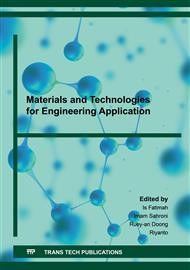[1]
T.N. Djanggola, Y. Yusriadi, M.R. Tandah, Formulasi Gel Ekstrak Patikan Kebo (Euphorbia hirta L.) dan Uji Aktivitas terhadap Bakteri Staphylococcus epidermidis. Galenika, J. Pharm. 2 (2016) 1-8.
DOI: 10.22487/j24428744.2016.v2.i2.5954
Google Scholar
[2]
K. Karim, M.R. Jura, S.M. Sabang, Uji Aktivitas Antioksidan Ekstrak Daun Patikan Kebo (Euphorbia hirta L.). J Akad Kim, 4 (2015) 1-8.
DOI: 10.33096/whj.v1i2.39
Google Scholar
[3]
Y. Hamdiyati, M. Kusnadi, I. Rahadian, Aktivitas Antibakteri Ekstrak Daun Patikan Kebo (Euphorbia hirta) terhadap Pertumbuhan Bakteri Staphylococcus epidermidis. Jurnal Pengajaran MIPA, 12 (2008) 1-10.
DOI: 10.18269/jpmipa.v12i1.312
Google Scholar
[4]
F.I. Mahmud, C. Mambo, H. Awaloei, Uji Daya Hambat terhadap Daun Patikan Kerbau (Euphorbia hirta) terhadap Pertumbuhan Bakteri Stapilococcus aureus dan Escherichia coli. Jurnal E Biomedik, 4 (2016) 1-5.
DOI: 10.35790/ebm.4.2.2016.14654
Google Scholar
[5]
A.S. Dimpudus, P.V.Y. Yamlean, A. Yudistira, Formulasi Sediaan Sabun Cair Antiseptik Ekstrak Etanol Bungan Pacar Air (Impatiens balsamina L.) dan Uji Efektivitasnya terhadap Bakteri Staphylococcus aureus secara In Vitro. Jurnal Farmasi UNSRAT, 6 (2017) 1-8.
DOI: 10.35799/pha.9.2020.31373
Google Scholar
[6]
A. Widyasanti, Y. Qurratu'aini, S. Nurjanah, Pembuatan Sabun Mandi Cair Berbasis VCO dengan Penambahan Biji Kelor. Jurnal Chemica At Natural Acta, 5 (2017) 1-8.
DOI: 10.24198/cna.v5.n2.14691
Google Scholar
[7]
S. Junita, A. Widyasanti, S. Nurjanah, Pengaruh Konsentrasi Minyak Kelapa Murni (Virgin Coconut Oil) dan Minyak Jarak (Castor Oil) terhadap Sifat Fisikokimia dan Organoleptik Sabun Mandi Cair. Jurnal Teknologi dan Industri Pertanian Indonesia, 9 (2017) 1-7.
DOI: 10.17969/jtipi.v9i1.6383
Google Scholar
[8]
D. Hasahatan, J. Sunaryo, L.N. Komariah, Pengaruh Ratio H2SO4 dan Waktu Reaksi terhadap Kuantitas dan Kualitas Biodiesel dari Minyak Jarak Pagar. Jurnal Teknik Kimia, 18 (2012) 1-11.
DOI: 10.32734/jtk.v11i2.8924
Google Scholar
[9]
P.Y. Irmayanti, N.P.A.D. Wijayanti, C.I.S. Arisanti, Optimasi Formula Sediaan Sabun Mandi Cair Ekstrak Kulit Manggis. Jurnal Kima, 8 (2014) 1-6.
Google Scholar
[10]
K. Ratnayani, A.A.I.A.M. Laksmiwati, N.P.I.P. Septian, Kadar Senyawa Fenolat pada Madu Randudan Madu Kelengkeng serta Uji Aktivitas Anti Radikal Bebas dengan Metode DPPH. Jurnal Kimia Fmipa Universitas Udayana, 6 (2012) 1-6.
Google Scholar
[11]
L.P. Malangngi, M.S. Sangi, J.J.E. Paendeong, Penentuan Kandungan Tanin dan Uji Aktivitas Antioksidan Ekstrak Biji Buah Alpukat (Persea americana Mill.). Jurnal Mipa Unsrat, 1 (2012) 1-6.
DOI: 10.35799/jm.1.1.2012.423
Google Scholar
[12]
B.B. Sembiring, Ma'mun, E.I. Gitting, Pengaruh Kehalusan Bahan dan Ekstraksi terhadap Mutu Ekstrak Temulawak (Curcuma xanthorriza Roxb). Balai Penelitian Tanaman Obat dan Aromatik, 17 (2006) 1-6.
DOI: 10.25181/jppt.v15i2.123
Google Scholar
[13]
S. Ariviani, Total Antioksidan Ekstrak Buah Salam dan Korelasinya dengan Kapasitas Anti Perosidasi pada Sistem Linoleat. Argointek Jurusan Ilmu dan Teknologi Pangan UNS, 4 (2010) 1-7.
Google Scholar
[14]
D. B. Widjayanto, Uji Aktivitas Antibakteri Ekstrak Rumput Laut Kappaphycus alvarezii dan Eucheuma denticullatum terhadap Bakteri Aeromonas hydrophila dan Vibrio harveyii. Jurnal Kelautan, 3 (2010) 1-17.
DOI: 10.31186/jenggano.4.1.105-114
Google Scholar
[15]
D. Sarastani, S.T. Soekarto, T.R. Muchtadi, D. Fardiaz, A. Apriyantono, Aktivitas Antioksidan dan Ekstrak Fraksi Ekstrak Biji Atung (Parinarium glaberrimum Hassk.). Jurnal Teknologi dan Industri Pangan, 8 (2002) 1-9.
DOI: 10.6066/jtip.2012.23.2.217
Google Scholar
[16]
T.N. Hertina, S. Dwiyanti, Pemanfaatan Ampas Kedelai Putih dan Ampas Kopi dengan Perbandingan Berbeda dalam Pembuatan Lulur Tradisional untuk Perawatan Tubuh. E Jurnal, 2 (2013) 1-8.
Google Scholar
[17]
I.W. Rahmi, W. Nurhikmah, E. Badia, M. Ifaya, Formulasi Sabun Pembersih Kewanitaan (Feminime Hygiene) dari Ekstrak Kulit Buah Durian (Durio zibethinus Murray). Jurnal Mandala Pharmacon Indonesia, 3 (2017) 1-10.
DOI: 10.35311/jmpi.v3i02.8
Google Scholar
[18]
R. Yulianti, D.A. Nugraha, L. Nurdianti, Formulasi Sediaan Sabun Mandi Cair Ekstrak Daun Kumis Kucing (Orthosiphon Aristatus (Bl) Miq.). Kartika Jurnal Ilmiah Farmasi, 3 (2015) 1-11.
DOI: 10.26874/kjif.v3i2.98
Google Scholar
[19]
L. Agustina, M. Yulianti, F. Shofiantari, I.F. Sabban, Formulasi dan Evaluasi Sabun Cair Esktrak Tomat sebagai Antioksidan. Journal Wiyata, 10 (2017) 1-6.
Google Scholar
[20]
D.F. Ayu, A. Ali, R. Sulaiman, Evaluasi Mutu Sabun Cair Padat dari Minyak Goreng Bekas Makanan Jajan Dikecamatan Tampan Kota Pekan Baru dengan Penambahan Natrium Hidroksida dan Lama Penyabunan.Laboratorium Analisis Hasil Pertanian Fakultas Pertanian Universitas Riau, 2009, pp.1-11.
DOI: 10.24961/j.tek.ind.pert.2018.28.2.210
Google Scholar
[21]
K. Hardian, A. Ali, Yusmarini, Evaluasi Mutu Sabun Padat Transparan dari Minyak Goreng Bekas dengan Penambahan SLS (Sodium Lauryl Sulfate) dan Sukrosa. Jom Faperta Fakultas Pertanian Universitas Riau, 1 (2014) 1-11.
DOI: 10.24961/j.tek.ind.pert.2018.28.2.210
Google Scholar
[22]
A.F. Ramdani, Nurbiyanti, H. Fitriani, Efektivitas Ekstrak Daun Patikan Kebo (Euphorbia hirta L.) Dibandingkan dengan Povidone Iodine 10% terhadap Ketebalan Epitelisasi pada Luka Insisi Tikus Putih Jantan. Tunas Medika Jurnal Kedokteran dan Kesehatan Universitas Swadaya Gunung Jati, (2016) 1-8.
DOI: 10.33533/jpm.v10i1.14
Google Scholar
[23]
M.S. Santoso, S. Tana, S.M. Mardiati, Efek Penambahan Virgin Coconut Oil (VCO) terhadap Perkembangan Jengger dan Bobot Testis Ayam (Gallus sp.). Buletin Anatomi dan Fisiologi Fakultas Matematika dan Ilmu Pengetahuan Alam Universitas Diponegoro, (2007) 1-8.
DOI: 10.52574/syiahkualauniversitypress.354
Google Scholar
[24]
N. Paramita, A. Fahrurroji, B. Wijayanto, Optimasi Sabun Cair Ekstrak Etanol Rimpang Zingiber officinale Rosc. var. rubrum. dengan Variasi Minyak Jarak dan Kalium Hidroksida. J Trop. Pharm. Chem. 2 (2014) 1-11.
DOI: 10.25026/jtpc.v2i5.76
Google Scholar
[25]
H. Predianto, L.I. Momuat, M.S. Sangi, Produksi Sabun Mandi Cair Berbahan Baku VCO yang Ditambahkan Dengan Ekstrak Wortel (Daucus carotta). Chem. Prog, 10 (2017) 1-5.
DOI: 10.35799/jis.17.2.2017.17968
Google Scholar


